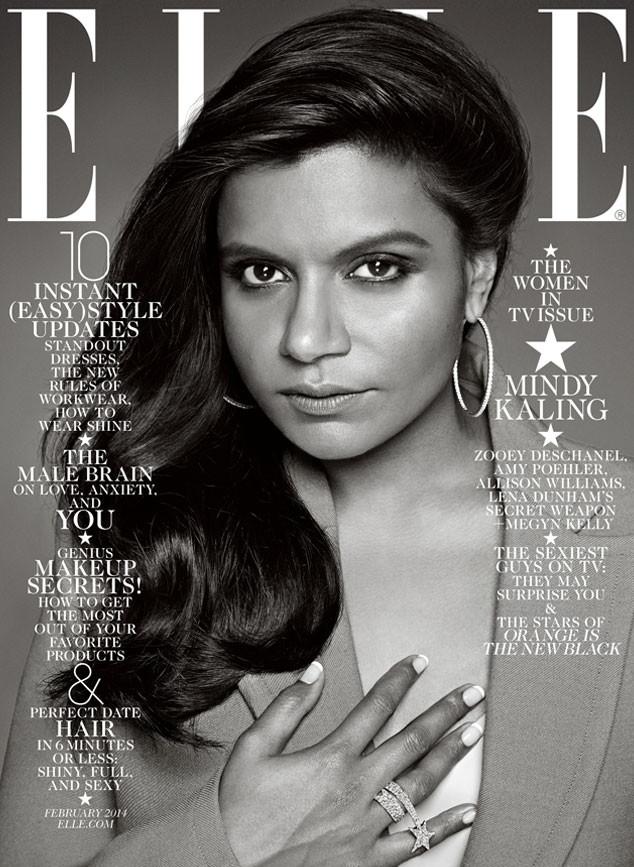Covering the Problem: Why criticism of Mindy Kaling and Lena Dunham’s covers is unfair
I’ll be honest: I don’t really follow the high fashion world. But even I was anticipating this month’s issues of Elle and Vogue, which are showcasing Mindy Kaling and Lena Dunham on their covers.
In an age where female directors are a rarity, Kaling and Dunham stand out, both for directing, writing, and starring in their own shows as well as being real women.
Both covers generated controversy for what some claimed was an offensive treatment of both women, since neither fits the “Hollywood mold,” as cover girls are usually tall, thin, and Caucasian. Kaling, a size 8 woman of color, was featured on one of four covers for Elle’s Women in Television issue. Her photo was close-up and in black and white, while her three, slim, Caucasian counterparts (Amy Poehler, Allison Williams, and Zooey Deschanel) had covers that showed their full bodies in color. Lena Dunham, also not a traditional model, seemed to be heavily photoshopped in her Vogue spread.
The lack of body positivity in this country is a relevant and important issue, as well as the unfair and impossible standards women are held to because of the media.
Still, the negative response to these covers was both overblown and inappropriate, hurting the women much more than the magazine companies.
By only focusing on the how the covers look, well-meaning people are objectifying these women. Both Kaling and Dunham are intelligent, successful women, and there is so much more to them than how they look. There’s so much more to talk about than the visual details of their photos.
Criticisms of Kaling’s cover emerged soon after its release. People pointed out that it was offensive that hers was the only one cropped. By not showing Kaling’s body, Elle was marginalizing the part of the population who looks like her.
Shortly after, Kaling tweeted that she loved her cover, and later commented on the David Letterman show that “the implication was, ‘What, Elle, you can’t put her big, fat body on the magazine?”
Still, some argued that the cover was still marginalizing average-sized women by cropping Kaling’s body, even if she was okay with it.
First of all, how this is even marginalization confuses me. Elle, a fashion magazine, has just put someone on the cover who is not only not heavily involved in the fashion world, but does not fit the covergirl stereotype. I don’t see what there is to criticize.
Neither Kaling nor her cover is a representative for the women of America. By demanding that Kaling’s whole body should be shown to better represent women, Kaling’s personality is being whittled down to nothing more than her body, like her figure is the only important thing about her. Complaining about something she thought was “glamorous and cool” makes no sense.
Another issue is that people are making assumptions about the motives behind the photo choice. Fashion experts have said that when designing issues with multiple covers, the goal is to make them look different. It’s also very possible that multiple shots were taken of each woman, and the other three didn’t look good close up.
Also, it’s hard to imagine Elle executives trying to be offensive when Kaling’s cover is, in my opinion, by far the best. It showcases her face in a way that none of the other three do.
Furthermore, Dunham has gone on record saying that she liked her spread, as well as pointing out that “a fashion magazine is like a beautiful fantasy. Vogue isn’t the place that we go to look at realistic women, Vogue is the place that we go to look at beautiful clothes and fancy places and escapism”.
Recently, Dunham criticized Jezebel, saying that she “felt completely respected by Vogue” and having the original photos posted without her consent “felt gross.” She went on to comment that Jezebel’s treatment of the unretouched photos was inappropriate. “[I]nstead of going like ‘hey we kind f*cked up, these pictures aren’t that retouched, Lena, enjoy the Vogue spread that you’ve been excited about since you were eight years old.’ They were like, ‘she’s not retouched, but she could’ve been. It was this weird almost political maneuvering that I just had a lot of trouble respecting.”
Elle and Vogue are both fashion magazines, so logically, it makes no sense to put anyone on the cover who isn’t heavily associated with the world of haute couture. There is no reason that anyone should expect them to have a social message. The very fact that both magazines put television comedians on their covers instead of models shows that they were trying to make a point, something that was overshadowed by the complaints about what the photos should have been. Do these two women being chosen as cover girls mark a change in the fashion industry? Maybe, maybe not, but protesting these magazines without giving them credit doesn’t help things like this happen again.
Since Kaling and Dunham are public figures, it’s often difficult to remember that they’re people just like you and me. When I was in 7th grade, I, like everyone else, took a school picture. I really liked it, but when I took it home to my parents, they immediately started to criticize the photo, saying that I looked bad and that I should get a retake. It ended up being really hurtful, especially coming from the two people who were supposed to be my biggest supporters. What Kaling and Dunham’s fans are doing is effectively the same.
Being on the cover of a magazine is a huge milestone in Kaling and Dunham’s careers. The controversy over the photos is just detracting from the accomplishment. Maybe it would be better if we could all just take a step back and let them enjoy it.

Meilan Steimle (12) is co-Editor-in-Chief of the Winged Post. She was a reporter her freshman year, Winged Post Opinion Editor her sophomore year and Winged...


















![“[Building nerf blasters] became this outlet of creativity for me that hasn't been matched by anything else. The process [of] making a build complete to your desire is such a painstakingly difficult process, but I've had to learn from [the skills needed from] soldering to proper painting. There's so many different options for everything, if you think about it, it exists. The best part is [that] if it doesn't exist, you can build it yourself," Ishaan Parate said.](https://harkeraquila.com/wp-content/uploads/2022/08/DSC_8149-900x604.jpg)




![“When I came into high school, I was ready to be a follower. But DECA was a game changer for me. It helped me overcome my fear of public speaking, and it's played such a major role in who I've become today. To be able to successfully lead a chapter of 150 students, an officer team and be one of the upperclassmen I once really admired is something I'm [really] proud of,” Anvitha Tummala ('21) said.](https://harkeraquila.com/wp-content/uploads/2021/07/Screen-Shot-2021-07-25-at-9.50.05-AM-900x594.png)







![“I think getting up in the morning and having a sense of purpose [is exciting]. I think without a certain amount of drive, life is kind of obsolete and mundane, and I think having that every single day is what makes each day unique and kind of makes life exciting,” Neymika Jain (12) said.](https://harkeraquila.com/wp-content/uploads/2017/06/Screen-Shot-2017-06-03-at-4.54.16-PM.png)








![“My slogan is ‘slow feet, don’t eat, and I’m hungry.’ You need to run fast to get where you are–you aren't going to get those championships if you aren't fast,” Angel Cervantes (12) said. “I want to do well in school on my tests and in track and win championships for my team. I live by that, [and] I can do that anywhere: in the classroom or on the field.”](https://harkeraquila.com/wp-content/uploads/2018/06/DSC5146-900x601.jpg)
![“[Volleyball has] taught me how to fall correctly, and another thing it taught is that you don’t have to be the best at something to be good at it. If you just hit the ball in a smart way, then it still scores points and you’re good at it. You could be a background player and still make a much bigger impact on the team than you would think,” Anya Gert (’20) said.](https://harkeraquila.com/wp-content/uploads/2020/06/AnnaGert_JinTuan_HoHPhotoEdited-600x900.jpeg)

![“I'm not nearly there yet, but [my confidence has] definitely been getting better since I was pretty shy and timid coming into Harker my freshman year. I know that there's a lot of people that are really confident in what they do, and I really admire them. Everyone's so driven and that has really pushed me to kind of try to find my own place in high school and be more confident,” Alyssa Huang (’20) said.](https://harkeraquila.com/wp-content/uploads/2020/06/AlyssaHuang_EmilyChen_HoHPhoto-900x749.jpeg)




